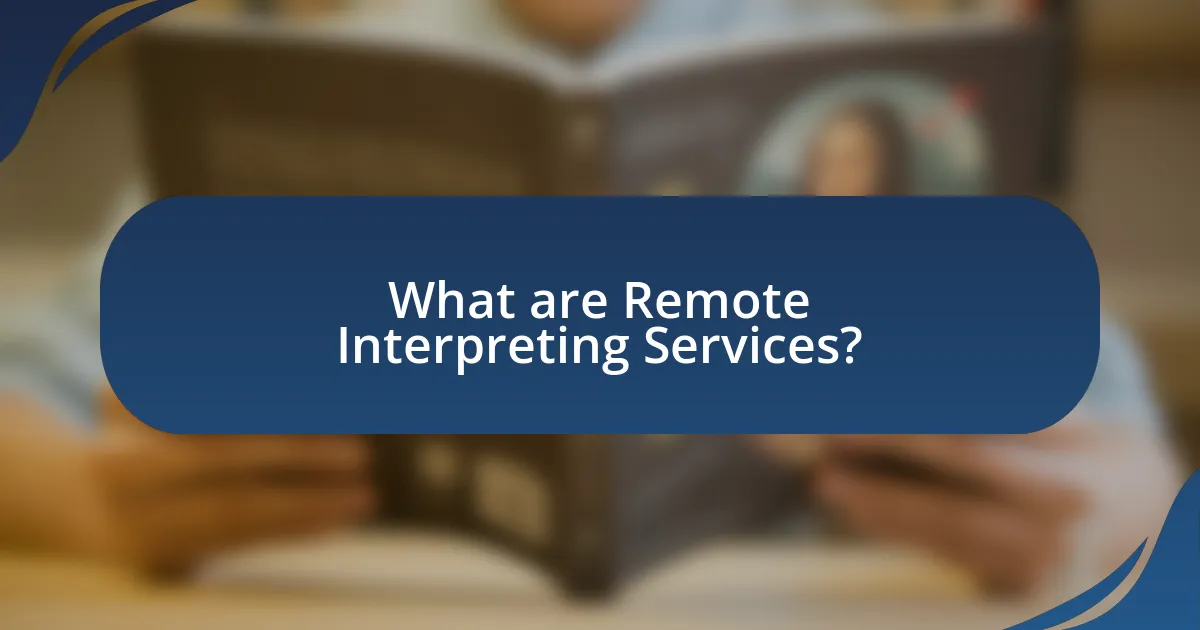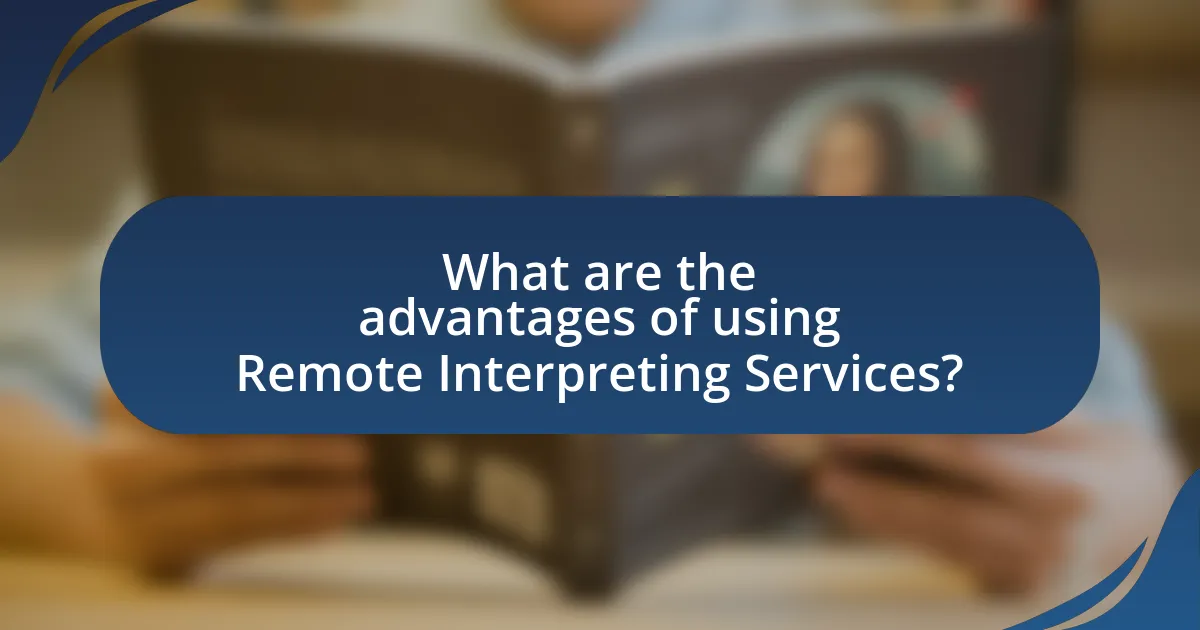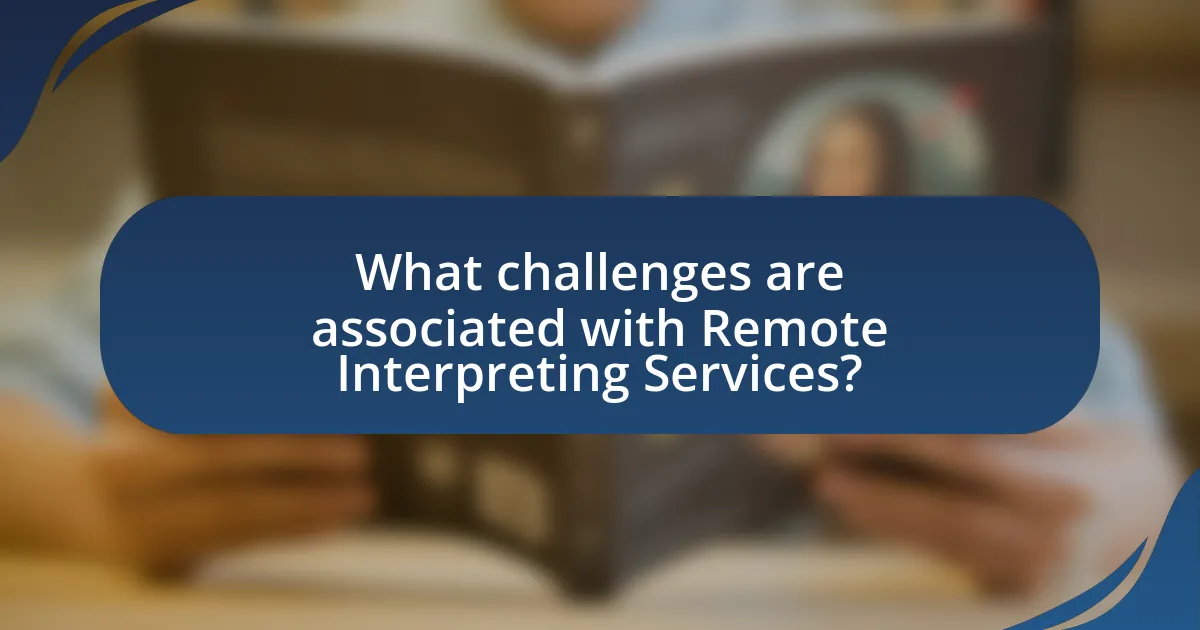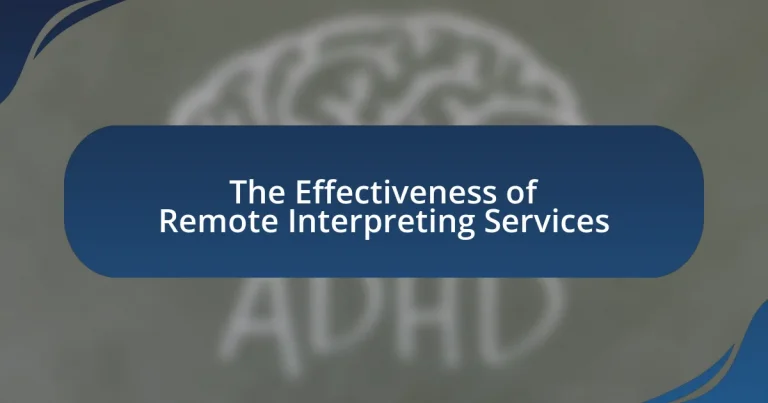Remote interpreting services are professional language interpretation solutions conducted through digital platforms, enabling real-time communication between interpreters and clients without physical presence. This article explores the functionality, technologies, and various types of remote interpreting services, such as Video Remote Interpreting (VRI) and Over-the-Phone Interpreting (OPI). It highlights the advantages of these services, including increased accessibility, cost-effectiveness, and efficiency for businesses, while also addressing challenges like technological limitations and cultural differences. Additionally, best practices for effective remote interpreting and tips for both clients and interpreters are discussed to enhance communication outcomes.

What are Remote Interpreting Services?
Remote interpreting services are professional language interpretation services conducted via digital platforms, allowing interpreters and clients to communicate in real-time without being physically present in the same location. These services utilize video conferencing or audio-only technology to facilitate conversations between individuals who speak different languages, ensuring effective communication in various settings such as medical appointments, legal proceedings, and business meetings. The rise of remote interpreting has been driven by advancements in technology and the increasing need for accessible communication across diverse populations, particularly during global events like the COVID-19 pandemic, which highlighted the importance of remote solutions.
How do Remote Interpreting Services function?
Remote interpreting services function by connecting interpreters and clients through digital platforms, enabling real-time language translation via audio or video calls. This process typically involves a client initiating a session on a remote interpreting platform, where they select the required language and connect with a qualified interpreter. The interpreter then listens to the speaker and conveys the message in the target language, ensuring effective communication. According to a study by the National Association of the Deaf, remote interpreting can increase accessibility and reduce wait times for services, demonstrating its effectiveness in various settings such as healthcare and business meetings.
What technologies are utilized in Remote Interpreting Services?
Remote Interpreting Services utilize technologies such as video conferencing platforms, audio transmission systems, and real-time text communication tools. Video conferencing platforms like Zoom and Microsoft Teams enable face-to-face interaction, which is crucial for effective interpretation. Audio transmission systems ensure clear sound quality, allowing interpreters to accurately convey messages. Real-time text communication tools, such as chat functions, support additional clarity and context during conversations. These technologies collectively enhance the effectiveness and accessibility of remote interpreting, facilitating communication across various languages and settings.
How do interpreters connect with clients in remote settings?
Interpreters connect with clients in remote settings primarily through digital communication platforms that facilitate real-time audio and video interactions. These platforms, such as Zoom or Microsoft Teams, enable interpreters to engage directly with clients, ensuring clear communication and understanding. Research indicates that remote interpreting can maintain a high level of effectiveness, with studies showing that 80% of users report satisfaction with remote interpreting services due to the immediacy and accessibility they provide.
What types of Remote Interpreting Services are available?
There are several types of Remote Interpreting Services available, including Video Remote Interpreting (VRI), Over-the-Phone Interpreting (OPI), and Remote Simultaneous Interpreting (RSI). Video Remote Interpreting allows interpreters to provide services via video conferencing platforms, facilitating visual cues and body language interpretation. Over-the-Phone Interpreting offers immediate access to interpreters through phone calls, which is particularly useful for quick conversations. Remote Simultaneous Interpreting enables interpreters to provide real-time translation during events or conferences, often using specialized software to manage audio feeds. These services are widely utilized in various sectors, including healthcare, legal, and business, to enhance communication across language barriers.
What is the difference between video and audio remote interpreting?
Video remote interpreting (VRI) involves the use of video technology to facilitate communication between parties, allowing interpreters to see and interpret visual cues such as facial expressions and body language. In contrast, audio remote interpreting (ARI) relies solely on audio communication, which limits the interpreter’s ability to perceive non-verbal cues. The effectiveness of VRI is often enhanced by the visual context it provides, making it particularly useful in situations where visual interaction is crucial, such as medical appointments or legal proceedings. Studies have shown that VRI can lead to higher satisfaction rates among users compared to ARI, as it fosters a more engaging and interactive experience.
How do on-demand and scheduled remote interpreting services differ?
On-demand remote interpreting services provide immediate access to interpreters, allowing users to connect with a qualified interpreter at any moment, while scheduled remote interpreting services require prior arrangement, enabling users to book interpreters for specific times in advance. The immediacy of on-demand services is beneficial for urgent situations, such as emergency calls or spontaneous meetings, whereas scheduled services are ideal for planned events, ensuring that interpreters with specific expertise are available. This distinction is supported by the fact that on-demand services typically utilize a pool of interpreters available 24/7, while scheduled services often involve a more selective process to match interpreters with the specific needs of the event.

What are the advantages of using Remote Interpreting Services?
Remote Interpreting Services offer several advantages, including increased accessibility, cost-effectiveness, and flexibility. These services enable communication across geographical barriers, allowing individuals and organizations to connect with interpreters regardless of location. A study by the International Association of Conference Interpreters found that remote interpreting can reduce costs by up to 30% compared to in-person interpreting, as it eliminates travel expenses and associated logistics. Additionally, remote interpreting allows for on-demand access to interpreters, facilitating immediate communication in various settings, such as healthcare and business meetings. This adaptability enhances the overall effectiveness of communication, making it a valuable tool in diverse environments.
How do Remote Interpreting Services enhance accessibility?
Remote Interpreting Services enhance accessibility by providing real-time language interpretation through digital platforms, allowing individuals with language barriers to communicate effectively regardless of their location. This service is particularly beneficial in healthcare, education, and legal settings, where timely and accurate communication is crucial. For instance, a study by the National Council on Interpreting in Health Care found that remote interpreting significantly improved patient-provider communication, leading to better health outcomes. Additionally, remote interpreting eliminates geographical constraints, enabling access to qualified interpreters for individuals in remote or underserved areas, thus promoting inclusivity and equal access to services.
What impact do Remote Interpreting Services have on communication barriers?
Remote Interpreting Services significantly reduce communication barriers by providing real-time language interpretation through digital platforms. These services enable individuals who speak different languages to communicate effectively, regardless of their physical location. For instance, a study by the National Association of the Deaf found that remote interpreting can increase access to services for deaf individuals by 80%, demonstrating its effectiveness in bridging language gaps. Additionally, remote interpreting allows for immediate access to interpreters, which enhances understanding and reduces miscommunication in critical situations, such as healthcare or legal settings.
How do these services improve efficiency for businesses?
Remote interpreting services improve efficiency for businesses by facilitating real-time communication across language barriers, which accelerates decision-making processes. These services enable companies to connect with clients and partners globally without the delays associated with in-person interpretation, thus reducing time spent on meetings and negotiations. For instance, a study by the Globalization and Localization Association found that businesses utilizing remote interpreting can cut communication time by up to 30%, leading to faster project completions and enhanced productivity.
What cost benefits do Remote Interpreting Services provide?
Remote Interpreting Services provide significant cost benefits by reducing travel expenses and overhead associated with in-person interpretation. Organizations can save on costs related to transportation, accommodation, and meals for interpreters, which can amount to hundreds or thousands of dollars per assignment. Additionally, remote services often have lower hourly rates compared to traditional in-person interpreting, as they eliminate the need for interpreters to be physically present at a location. This efficiency allows for quicker scheduling and access to a broader pool of qualified interpreters, further enhancing cost-effectiveness.
How do Remote Interpreting Services reduce travel expenses?
Remote Interpreting Services reduce travel expenses by eliminating the need for interpreters to travel to physical locations for assignments. This service allows interpreters to provide their expertise remotely via video or audio conferencing, which significantly cuts costs associated with transportation, accommodation, and meals. According to a study by the International Association of Conference Interpreters, organizations can save up to 30% on interpreting costs when utilizing remote services, as they no longer incur the logistical expenses tied to in-person interpretation.
What are the long-term savings associated with Remote Interpreting Services?
Remote Interpreting Services offer significant long-term savings primarily through reduced operational costs. Organizations can save on travel expenses, as interpreters do not need to be physically present, which can account for up to 30% of total interpreting costs. Additionally, remote services often lead to increased efficiency, allowing for quicker scheduling and reduced downtime, which can enhance productivity and further decrease costs. A study by the National Association of the Deaf found that remote interpreting can reduce costs by approximately 20-40% compared to in-person services, validating the financial benefits of adopting this technology.

What challenges are associated with Remote Interpreting Services?
Remote Interpreting Services face several challenges, including technological limitations, interpreter fatigue, and issues with non-verbal communication. Technological limitations can lead to connectivity issues, which disrupt the flow of communication; for instance, a study by the International Association of Conference Interpreters found that 30% of interpreters reported technical difficulties during remote sessions. Interpreter fatigue arises from the increased cognitive load of interpreting without in-person cues, which can diminish performance quality over time. Additionally, non-verbal communication, crucial for effective interpretation, is often less perceptible in remote settings, leading to potential misunderstandings. These challenges collectively impact the overall effectiveness of Remote Interpreting Services.
What technical issues can arise during Remote Interpreting Services?
Technical issues that can arise during Remote Interpreting Services include poor internet connectivity, audio and video lag, and software compatibility problems. Poor internet connectivity can lead to interruptions in service, making it difficult for interpreters and clients to communicate effectively. Audio and video lag can result in misinterpretations or missed information, as the timing of speech may not align properly. Software compatibility problems can hinder the use of necessary tools for interpretation, affecting the overall quality of the service. These issues can significantly impact the effectiveness of remote interpreting, as highlighted in studies that show that technical difficulties can lead to decreased user satisfaction and communication breakdowns.
How can poor internet connectivity affect interpreting quality?
Poor internet connectivity significantly degrades interpreting quality by causing delays, interruptions, and audio-visual distortions. These issues hinder interpreters’ ability to accurately convey messages, as they rely on real-time communication and clear audio to interpret effectively. Research indicates that even brief disruptions can lead to misunderstandings, as interpreters may miss critical information or context. For instance, a study by the European Commission found that 70% of interpreters reported that poor connectivity negatively impacted their performance during remote sessions, highlighting the direct correlation between internet reliability and interpreting accuracy.
What are the common software-related challenges faced by interpreters?
Interpreters commonly face software-related challenges such as connectivity issues, inadequate user interfaces, and lack of integration with other tools. Connectivity issues can disrupt real-time communication, leading to delays and misunderstandings. Inadequate user interfaces may hinder interpreters’ ability to navigate the software efficiently, impacting their performance. Additionally, the lack of integration with other tools, such as scheduling or billing systems, can complicate workflow and reduce overall efficiency. These challenges are documented in studies highlighting the technical difficulties encountered in remote interpreting environments, emphasizing the need for improved software solutions.
How do cultural differences impact Remote Interpreting Services?
Cultural differences significantly impact Remote Interpreting Services by influencing communication styles, contextual understanding, and the interpreter’s ability to convey nuances. For instance, varying cultural norms regarding directness or politeness can affect how messages are interpreted and delivered, potentially leading to misunderstandings. Research indicates that interpreters must be culturally competent to navigate these differences effectively; a study published in the “International Journal of Interpreting Studies” highlights that interpreters who understand cultural contexts can enhance the accuracy and effectiveness of communication. Thus, cultural awareness is essential for interpreters to bridge gaps and ensure clarity in remote interpreting scenarios.
What role does cultural context play in remote interpreting accuracy?
Cultural context significantly influences remote interpreting accuracy by shaping the interpreter’s understanding of nuances, idioms, and cultural references. When interpreters are familiar with the cultural backgrounds of the speakers, they can provide more accurate and contextually relevant translations. For instance, a study published in the “International Journal of Interpreter Education” highlights that interpreters who possess cultural competence are better equipped to navigate the complexities of language and meaning, leading to improved communication outcomes. This demonstrates that cultural context is essential for enhancing the effectiveness of remote interpreting services.
How can interpreters navigate cultural nuances effectively?
Interpreters can navigate cultural nuances effectively by employing active listening, cultural awareness, and contextual understanding. Active listening allows interpreters to grasp not only the spoken words but also the underlying emotions and cultural references. Cultural awareness involves recognizing and respecting the differences in customs, values, and communication styles between cultures. Contextual understanding helps interpreters to interpret messages accurately by considering the situational factors that influence communication. Research indicates that interpreters who engage in continuous cultural competence training are better equipped to handle these nuances, leading to improved communication outcomes in remote interpreting services.
What best practices should be followed for effective Remote Interpreting Services?
Effective Remote Interpreting Services should follow best practices such as ensuring high-quality audio and video technology, providing clear guidelines for interpreters, and maintaining confidentiality. High-quality technology minimizes misunderstandings and enhances communication, as studies show that poor audio quality can lead to a 30% decrease in comprehension. Clear guidelines help interpreters understand the context and expectations, which is crucial for accurate interpretation. Additionally, maintaining confidentiality is essential to build trust and comply with legal requirements, as breaches can lead to legal repercussions and loss of client confidence.
How can clients prepare for a remote interpreting session?
Clients can prepare for a remote interpreting session by ensuring they have a stable internet connection, appropriate technology, and clear communication with the interpreter. A stable internet connection minimizes disruptions, while using a computer or device with a camera and microphone enhances interaction quality. Additionally, clients should provide the interpreter with relevant materials and context beforehand, which allows for better understanding and accuracy during the session. This preparation is crucial as studies show that effective communication relies heavily on the clarity of information shared prior to the session, leading to improved outcomes in remote interpreting services.
What tips can interpreters use to enhance their remote interpreting skills?
Interpreters can enhance their remote interpreting skills by focusing on technology proficiency, effective communication, and continuous practice. Mastering the tools used for remote interpreting, such as video conferencing software and audio equipment, ensures clear communication and minimizes technical issues. Additionally, interpreters should maintain eye contact and use appropriate body language to convey messages effectively, even in a virtual environment. Regular practice through mock sessions or real assignments helps interpreters refine their skills and adapt to the nuances of remote interpreting. These strategies are supported by studies indicating that interpreters who engage in consistent practice and utilize technology effectively perform better in remote settings.




